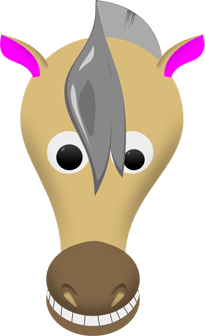
From RÚV comes a brief story about a young girl who claims to have taught her horse how to count and add. Now I have no idea whether this horse can really do math, or if it is just another ‘Clever Hans‘ case, but I did like how short the story was and thought it would make a great beginner lesson.
There is also a video clip from the news broadcast to go with the report, so read the text and then watch and listen. It’s a good way to reinforce what you are learning; see which words from the text you can recognize in the video. 🙂
The story begins with:
“Það er ýmsu skrökvað upp á Hafnfirðinga, en það er engin lygi að þar í bæ býr gáfaður hestur.”
“There are various things lied about up in Hafnfirðingur, but it is no lie that an intelligent horse live in this town.”
I’m not exactly sure what the difference is between the two verbs for “to lie” – skrökva, as in the text, and ljúga. Possibly skrökva is a bit milder?
The verb að telja is used, among other things, for counting:
| að telja – to count | ||
|---|---|---|
| present | past | |
| ég | tel | taldi |
| þú | telur | taldir |
| það | telur | taldi |
| við | teljum | töldum |
| þið | teljið | tölduð |
| þau | telja | töldu |
Ég kann að telja upp að tíu. – I can count up to ten.
It is also used for consider:
Hesturinn er talinn gáfaður. – The horse is considered intelligent.
The phrase spænska sporið is referring to the Spanish Walk, a move that some show horses are taught.
spor n (-s, -) – footstep; gait
The story contains the expression stakk upp á því, which means “suggested”. It comes from the verb að stinga – to stab, strike
| að stinga – to stab, strike | ||
|---|---|---|
| present | past | |
| ég | sting | stakk |
| þú | stingur | stakkst |
| það | stingur | stakk |
| við | stingum | stungum |
| þið | stingið | stunguð |
| þau | stinga | stungu |
And finally:
“En þetta er ekki það eina. Skuggi getur líka lagt saman.”
“But that’s not all. Skuggi can also do addition.”
The expression leggja saman means to add, from the verb að leggja – to lay, put.
Hopefully this helps you get through the text; treat yourself to a sugar cube when you’re done 🙂
